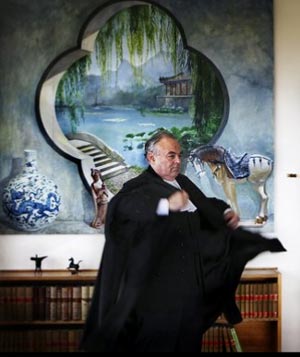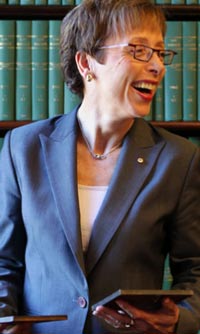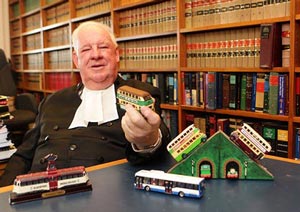Much ado stirred by Sydney Morning Herald's series on judges at work and play ... On the record and unexpurgated ... How will we ever shut them up now?  Spigelman CJ: insisted that interviews be on the recordWhere's Viscount Kilmuir (aka David Maxwell Fyfe) when you need him?
Spigelman CJ: insisted that interviews be on the recordWhere's Viscount Kilmuir (aka David Maxwell Fyfe) when you need him?
Over five recent days The Sydney Morning and The Sun-Herald published at least 12 stories on the joys and vicissitudes of judging, along with numerous charts and tables.
The series was billed "Behind the Bench".
In all 22 judicial people from the Supreme, District and Magistrates Courts went on the record for the paper. The idea was to strip back the veneer and hear from the judges first hand about their gripes and triumphs.
It was an unprecedented avalanche of judicial opining.
The last time something of this scale was tried happened 26 years ago when Melbourne journalist Robert Thomson interviewed 27 judges. Most of them were not on the record.
Thomson scored a scoop when a couple of his interviewees claimed they'd been pressured by politicians seeking to influence the outcome of a case.
"Unthinkable" these days, of course. All now insist their independence is unassailable - although there was no complaint about being required to apply to the attorney general to be allowed to sit on terror or gang cases.
Thomson turned his survey into a book: The Judges: A Portrait of the Australian Judiciary. (See review by former Justice McGregor.)
Thommo ultimately fetched-up as managing editor of Rupe Murdoch's Wall Street Journal, so there may be good prospects ahead for the four journalists who were assigned to the recent task by the SMH: Deborah Snow, Joel Gibson, Elizabeth Sexton and Geesche Jacobsen.
In this later, more open, lunge into the limelight the judges unloaded their entire selection of pet topics: the media's over-egged reports on sentencing, the independence of the judiciary, the failure of attorneys general to protect judges from attack, the isolation, the difficulties imposed by legislation in sentencing, the law and order elections, constraints on social behavior and the camaraderie. McColl: laughingThe was also a terrific photo essay by Brendan Esposito of judges unposed, including a unique shot of Ruth McColl laughing.
McColl: laughingThe was also a terrific photo essay by Brendan Esposito of judges unposed, including a unique shot of Ruth McColl laughing.
Most judges are notoriously conscious about appearing idiotic when they open their traps in public, so getting them on the record saying anything, even the self-serving stuff, was a minor triumph.
There were some memorable insights. Justice Peter Young grew up near a bus stop, which somehow inspired him to collect model omnibuses. "I've always been interested in timetables and buses," the former head of the equity division said.
Apart from Justice George Palmer's other life as a composer and Peter McClellan's career as a wine maker, the journalists were scratching bravely to find interests of even the remotest fascination. It boiled down to Helen Murrell's yoga and McColl's bicycling.
Deputy Chief Magistrate Jane Culver revealed she declines even one glass of wine at social functions because she is handing out sentences to drink-drivers, including the buffo Channel Seven news boss Peter Meakin.
Peter Young also showed just how complicated life can get for judges. He said he is invited to about 20 Christmas parties each year, but has to refuse the lot.
"If I go to one, why am I going to that one rather than to the other 19?"
Sentencing is the one area that draws so much criticism, from victims and sections of the media alike - and the judges are largely left defenceless by the attorneys general of the day.
Considerable effort went into explaining the technicalities and complications inherent in sentencing. McColl grumbled:
"I do wish the media understood the work of the law better and didn't assume that every sentence the victim disagrees with must be wrong."
 Young: grew up near a bus stopThere was mention of the need for greater efficiency on the part of courts, however no one picked up the hot potato of the crushing money-chomping regime over which judges benignly preside.
Young: grew up near a bus stopThere was mention of the need for greater efficiency on the part of courts, however no one picked up the hot potato of the crushing money-chomping regime over which judges benignly preside.
Spiggsy Spigelman said he was opposed to increasing the size of the Supreme Court from its current 52 judges.
The collegiate atmosphere is the "glue that makes this court function more than anything else", he said.
If too many cases are filed, "we'll sent more to the District Court".
The series exercise came about in an unexpected way. The SMH first approached Spigelman for an off-the-record interview. He replied he would do it on-the-record. The paper floated the idea of asking about 50 judges to give the public a glimpse into their lives and thinking.
Of the 48 they wrote to about half said they'd do it. The only condition was imposed by the Chief Justice. Boldly, he insisted that all who participated had to do it on the record.
The fall-out was predictable, ranging from "why wasn't I asked?" to "speaking out like this is going too far".
The Supreme Court press office helped get the project over the line. Information officer Sonya Zadel coincidentally happened to be the sister-in-law of photographer Brendan Esposito.
Spiggsy said that the photographer should not take more than half-an-hour with each judge so that the flow of judicial productiveness would not be unnecessarily disturbed.
The result was a terrific, unposed, photo essay of judges behind the scenes.
The trouble is that once judges are lured into the open, they are unlikely ever to shut-up.
Judges who spoke on the record were:
Supreme Court
- James Spigelman
- Rod Howie
- David Kirby
- Megan Latham
- Peter McClellan
- Ruth McColl
- Robert McDougall
- George Palmer
- Michael Slattery
- Anthony Whealy
- Peter Young
District Court
- Reg Blanch
- Richard Cogswell
- Paul Conlon
- Helen Murrell
- Dianne Truss
- Peter Zahra
Local Court
- Graeme Henson
- Jane Culver
- Geoff Dunlevy
- David Heilpern
- Daphne Kok
See the SMH series: Behind the bench